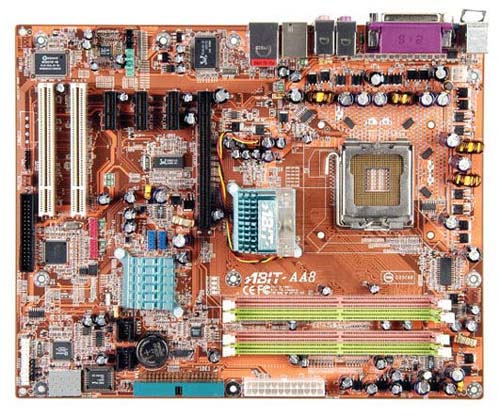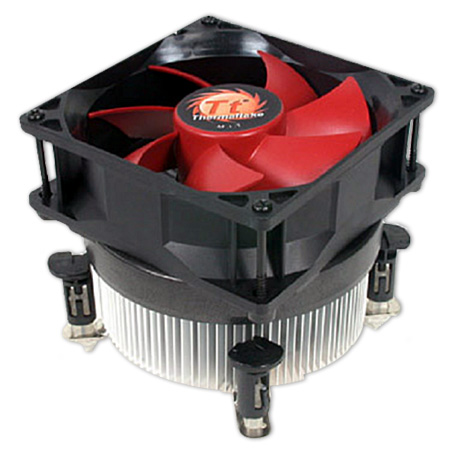DDR2 Roundup: Reaching for 667 and Beyond
by Wesley Fink on July 8, 2004 12:09 AM EST- Posted in
- Memory
New Test Components
Processor
While we report the CPU used for memory testing as the 2.8E LGA 775, the processor is a 3.6ES LGA 775 set to a lower 14 ratio. This particular LGA 775 CPU has demonstrated the ability to run 4.0GHz at near default voltage. This allows a range of available FSB at the lowest 14 multiplier to about 285 or DDR2 760. The production 2.8E LGA 775 has the same 14 multiplier and overclocking results should be comparable on motherboards that have developed methods to bypass the 925X/915 10% overclock lock.Motherboard

In the first report of manufacturers finding ways to circumvent the Intel 10% overclock lock, we found that the Asus P5AD2 was able to reach a top overclock of 248. This is currently slightly below the memory timing of 250 required to run memory at DDR2 667, at the standard 3:4 Intel memory ratio for DDR2. Further testing for an upcoming 925X motherboard roundup revealed that the Abit AA8 was capable of reaching 258 FSB setting with a stock PCIe video card and SATA hard drive. The Abit is capable of reaching even higher overclocks with an IDE hard drive and/or PCI video because we have found the current limitation to be a result of a non-locking PCIe/SATA bus speed. Abit is working to resolve this issue, if it is resolvable with the 925X chipset, and an updated BIOS with a fixed PCIe/SATA clock should be capable of even higher overclocks. Because the Abit could reach DDR2 667, it was used as the motherboard for memory testing.
Power Supply

The Power Supply for our new test bed is the remarkable OCZ PowerStream 520, which you will see in a future article by Kris Kubicki, the AnandTech power supply guru. While on the expensive side, the OCZ PowerStream 520 has individually powered rails, like the Antec TruePower units. The rails are individually adjustable with LED readouts for special tweaking needs. PowerStream features high wattage, beefed up connectors for video and hard drive, SATA connectors, and both the 24-pin ATX connector required for 925X/915/server and a 20-pin adapter for a standard 875/865/Athlon system. This may be overkill for an average end user, but these are excellent features for a memory test bed where overclocking, power-hungry processors, and power-hungry video is the norm.
Heat Sink Fan

The Thermaltake Jungle512 (CL-P0037) is one of the first third-party LGA 775 heat sinks to appear in our lab. It appears to do a decent job of cooling with the demands of the LGA 775 at overclocked speeds.










20 Comments
View All Comments
betatest3 - Wednesday, August 18, 2004 - link
The DDR2 667 memory is allready available and price is around $245 to $270 for 512mb .The only memory I found was made by Crucial and some Generic by doing a search on pricewatch.com site The $245 memory can be seen here -->http://www.newegg.com/app/viewproductdesc.asp?DEPA...
Hmm.. this DDR2 memory was just made for Intel ??? or maybe in newer motherboards can be used with AMD also ? I would not think a newer memory made by many company's would just be designed for intel especially when alot of manufacturers are jumping over to AMD or can AMD use this 667 memory ?
jiulemoigt - Monday, July 12, 2004 - link
A very funny thought aquired to me after reading the older article on AMD's DDR2 stance. If their waiting for DDR2 667 and the memory is ready but quitly being called 533 does that mean AMD may actully be ready to pull a fast on Intel? Considering the way the chip is designed could the memory controller be flashed to update to the memory controller the same way the other frequencies are set? Oh and I would not buy a LGA socket the pin's being spring loaded just looks to be trouble :o cool articleWesley Fink - Friday, July 9, 2004 - link
FlameDeer -Good catch. P. 6 is corrected to 1032FSB.
FlameDeer - Friday, July 9, 2004 - link
Thanks for quick respond at #10, Wesley! :)Really appreciate your hours and hours of hard work to publish this very first hand thorough DDR2 roundup! :)
A quick look again of this good article, I noticed something need to ask. In page 7 till page 14, is that "258FSB" of 686DDR in every table mean 4 x 258 = "1032FSB"? And is this FSB related to page 6 settings no.3 of "1016FSB/DDR2-686"? Just curious, thank you! :)
pookie69 - Friday, July 9, 2004 - link
Cool - i think i understand that now.Thanks for replying and explaining. Appreciated :)
Wesley Fink - Friday, July 9, 2004 - link
The ratio is 3:4 looking at base clocks (200 to 266). The bus is then quad-pumped to 800 and memory is DOUBLE Data Rate or 533. I do agree it is a bit confusing since the final 800 ratio is 3:2 of the final DDR2 ratio (533).The 975/865 standard was 1:1 since the base clocks are 200, even though the final speeds were 800FSB (quad) and 400 DDR. It was never called 2:1.
pookie69 - Friday, July 9, 2004 - link
Nice article - good job :)Only one point; where it reads;
"This is currently slightly below the memory timing of 250 required to run memory at DDR2 667, at the standard 3:4 Intel memory ratio for DDR2."
>>> shouldn't that be a 3:2 ratio?
Or am i confused :S
Nice article again - keep up the good work Mr. Fink ;)
TrogdorJW - Friday, July 9, 2004 - link
I think a better conclusion might have been: And the winner is... NO ONE! (Or everyone, depending on whether you see the glass as half full or half empty.) While there are definitely measurable differences in performance between the various memories, reality is that only Quake 3 and Enemy Territory are meaningful benchmarks. Seeing that Quake 3 is one of the most bandwidth hungy games of all time, it's rather telling that a 15.4% advantage in Sandra only equates to a 2.7% performance difference in Quake 3 (and even less in W:ET). I'm not criticizing your work, mind you - just pointing out that the best case scenario of Sandra Unbuffered RAM tests are not the way we actually use our systems.At some point, it would be nice to see a memory roundup that included all the benchmarks that are used in CPU and graphics comparisons. Obviously, that wouldn't be a prudent use of your time when we're still being limited by the motherboard. However, in another six months, I would like to see a memory comparison put together that broadened the field of view in regards to benchmarks.
Great article, though. It will certainly be interesting to see how far each memory type can actually overclock when the motherboard is no longer the limiting factor. For the present, though, it looks like we might as well just save our pennies and buy cheaper DDR2 modules. (Not that any of them are actually "cheap"....)
Pumpkinierre - Thursday, July 8, 2004 - link
I suppose with all these new goodies, Wesley, you are going to give up on the excellent straight DDR articles you used to do.For the tRAS, the usual formula for DDR is: tRCD+CAS latency + 2 cycles, see:
http://www.mushkin.com/mushkin/pop-up/latencies.ht...
So that seems to work for DDR2 at tRAS >10. I dont know why DDR2 still works at tRAS of 4 though. I also dont know why nForce chipsets have their tRAS so high (10-12) on ordinary DDR.
You've got an engineering sample (multiplier unlocked) Prescott that o'clocks well. So you ought to do some tests at same CPU speed but different FSBs like you have done on the a64s. I know you might think it is stupid given that retail cpus are multiplier locked but some of us want to see whether it is better to put more money in a higher grade cpu or get a cheaper one and o'clock it high using more expensive high speed low latency memory. You had'nt done this with the N'wood/i875 memory tests either, but I cant remember whether you've got a good N'wood engineering sample lying around. Anyway just a suggestion.
ariafrost - Thursday, July 8, 2004 - link
Now if only DDR2 latencies were lower and the pricetag was less than DDR1 :)